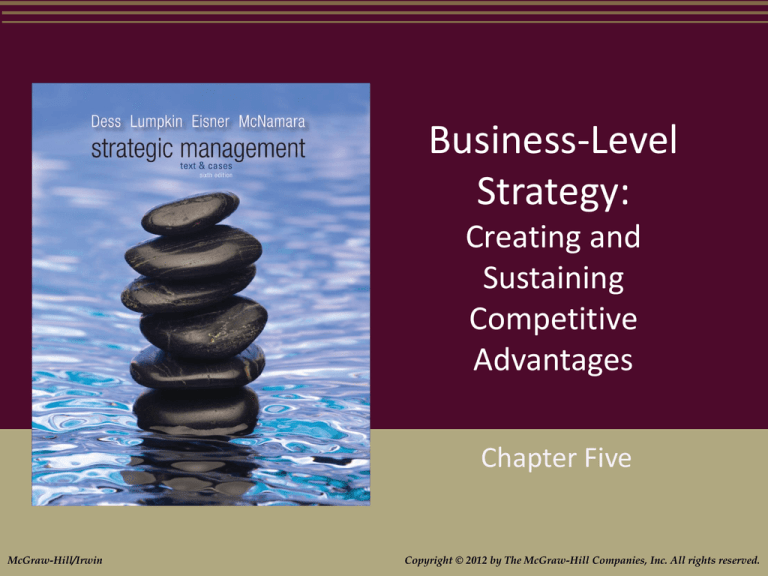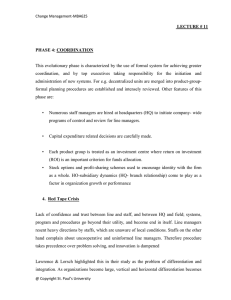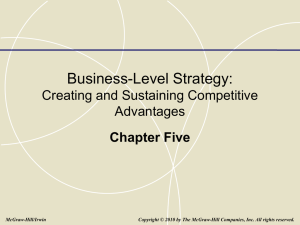
Business-Level
Strategy:
Creating and
Sustaining
Competitive
Advantages
Chapter Five
McGraw-Hill/Irwin
Copyright © 2012 by The McGraw-Hill Companies, Inc. All rights reserved.
Learning Objectives
After reading this chapter, you should have a good
understanding of:
LO5.1 The central role of competitive advantage in the
study of strategic management and the three
generic strategies: overall cost leadership,
differentiation, and focus.
LO5.2 How the successful attainment of generic
strategies can improve a firm’s relative power
vis-à-vis the five forces that determine an
industry’s average profitability.
LO5.3 The pitfalls managers must avoid in striving to
attain generic strategies.
LO5.4 How firms can effectively combine the generic
strategies of overall cost leadership and
differentiation.
5-2
Learning Objectives (cont.)
LO5.5 What factors determine the sustainability of
a firm’s competitive advantage.
LO5.6 How Internet-enabled business models are
being used to improve strategic positioning.
LO5.7 The importance of considering the industry
life cycle to determine a firm’s business-level
strategy and its relative emphasis on
functional area strategies and value-creating
activities.
LO5.8 The need for turnaround strategies that
enable a firm to reposition its competitive
position in an industry.
5-3
Three Generic Strategies
Exhibit 5.1
5-4
Three Generic Strategies
Overall cost leadership
Low-cost-position relative to a firm’s peers
Manage relationships throughout the entire
value chain
Differentiation
Create products and/or services that are
unique and valued
Non-price attributes for which customers will
pay a premium
5-5
Three Generic Strategies
Focus strategy
Narrow product lines, buyer segments, or
targeted geographic markets
Attain advantages either through
differentiation or cost leadership
5-6
Example
Companies pursuing an overall cost
leadership strategy
McDonalds
Wal-Mart
Companies pursuing a differentiation
strategy
Harley Davison
Apple
Companies pursuing a focus strategy
Rolex
Lamborghini
5-7
Competitive Advantage and
Business Performance
Exhibit 5.2
5-8
Overall Cost Leadership
Tight set of interrelated tactics that
includes:
Tight cost and overhead control
Avoidance of marginal customer accounts
Cost minimization in all activities in the firm’s
value chain
5-9
Overall Cost Leadership
Experience curve
refers to how business “learns” to lower
costs as it gains experience with production
processes
with experience, unit costs of production
decline as output
increases in most
industries
5-10
Overall Cost Leadership
Competitive parity
a firm’s achievement of similarity, or being
“on par,” with competitors with respect to low
cost, differentiation, or other strategic
product characteristic.
5-11
Comparing Experience Curve Effects
Exhibit 5.4
5-12
Improving Competitive Position
vis-à-vis the Five Forces
An overall low-cost position
Protects a firm against
Provides substantial entry
rivalry from competitors
Protects a firm against
powerful buyers
Provides more flexibility
to cope with demands
from powerful suppliers
for input cost increases
barriers from economies
of scale and cost
advantages
Puts the firm in a
favorable position with
respect to substitute
products
5-13
Pitfalls of Overall Cost
Leadership Strategies
Too much focus on one or a few value-chain
activities
All rivals share a common input or raw material
The strategy is imitated too easily
A lack of parity on differentiation
Erosion of cost advantages when the pricing
information available to customers increases
5-14
Differentiation
Differentiation strategy
a firm’s generic strategy based on creating
differences in the firm’s product or service
offering by creating something that is
perceived industry-wide as unique and
valued by customers.
5-15
Differentiation
Prestige or brand image
Technology
Innovation
Features
Customer service
Dealer network
5-16
Differentiation: Improving Competitive
Position
Creates higher entry barriers due to customer
loyalty
Provides higher margins that enable the firm to
deal with supplier power
Establishes customer loyalty and hence less
threat from substitutes
5-17
Potential Pitfalls of
Differentiation Strategies
Uniqueness that is not valuable
Too much differentiation
Too high a price premium
Differentiation that is easily imitated
Diffusion of brand identification through
product-line extensions
Perceptions of differentiation may vary between
buyers and sellers
5-18
QUESTION
High product differentiation is generally
accompanied by
A. Higher market share
B. Decreased emphasis on competition based
on price
C. Higher profit margins and lower costs
D. Significant economies of scale
5-19
Focus
Focus is based on the choice of a narrow
competitive scope within an industry
Firm selects a segment or group of
segments (niche) and tailors its strategy to
serve them
Firm achieves competitive advantages by
dedicating itself to these segments
exclusively
5-20
Focus
Cost focus
firm strives to
create a cost
advantage in its
target segment
Differentiation
focus
firm seeks to
differentiate in its
target market
5-21
Focus: Improving Competitive Position
Focus
Creates barriers of either cost leadership or
differentiation, or both
Used to select niches that are least
vulnerable to substitutes or where
competitors are weakest
5-22
Pitfalls of Focus Strategies
Erosion of cost advantages within the narrow
segment
Focused products and services still subject to
competition from new entrants and from
imitation
Focusers can become too focused to satisfy
buyer needs
5-23
Three Combination Approaches
Automated and flexible manufacturing systems
Exploiting the profit pool concept for competitive
advantage
Coordinating the “extended” value chain by way
of information technology
5-24
U.S. Automobile Industry’s Profit Pool
Exhibit 5.8
5-25
Pitfalls of Combination Strategies
Firms that fail to attain both strategies may
end up with neither and become “stuck in the
middle”
Underestimating the challenges and expenses
associated with coordinating value creating
activities in the extended value chain
Miscalculating sources of revenue and profit
pools in the firm’s industry
5-26
Internet-Enabled Low Cost Leader
Strategies
Exhibit 5.9
5-27
Internet-Enabled Differentiation
Strategies
Exhibit 5.10
5-28
Internet-Enabled Focus Strategies
Exhibit 5.11
5-29
Industry Life-Cycle Stages:
Strategic Implications
Industry life cycle
refers to the stages of introduction, growth,
maturity, and decline that typically occur over
the life of an industry
5-30
Stages of the Industry Life Cycle
Exhibit 5.12
5-31
QUESTION
The most likely time to pursue a harvest strategy
is in a situation of
A. High growth
B. Strong competitive advantage
C. Mergers and acquisitions
D. Decline in the market life cycle
5-32
Strategies in the Introduction Stage
Introduction stage
the first stage of the industry life cycle,
characterized by (1) new products that are
not known to customers, (2) poorly defined
market segments, (3) unspecified product
features, (4) low sales growth, (5) rapid
technological change, (6) operating losses,
and (7) a need for financial support.
5-33
Industry Life-Cycle Strategies
For the Introduction Stage:
Develop product and get users to try it
Generate exposure so product becomes
“standard”
5-34
Industry Life-Cycle Strategies
Growth stage
The second stage of the product life cycle,
characterized by (1) strong increases in
sales; (2) growing competition; (3)
developing brand recognition; and (4) a need
for financing complementary value-chain
activities such as
marketing, sales,
customer service, and
research and
development.
5-35
Industry Life-Cycle Strategies
For the Growth Stage:
Brand recognition
Differentiated products
Financial resources to support valuechain activities
5-36
Industry Life-Cycle Strategies
Maturity stage
The third stage of the product life cycle,
characterized by (1) slowing demand growth,
(2) saturated markets, (3) direct competition,
(4) price competition, and (5) strategic
emphasis on efficient operations.
Reverse positioning, breakaway positioning
5-37
Industry Life-Cycle Strategies
Decline stage
The fourth stage of the product life cycle,
characterized by (1) falling sales and profits,
(2) increasing price competition, and (3)
industry consolidation.
5-38
Strategies in the Decline Stage
For the Decline Stage
Maintaining
Harvesting
Exiting the market
Consolidation
5-39
Turnaround Strategies in the Life Cycle
Turnaround strategy
a strategy that reverses a firm’s decline in
performance and returns it to growth and
profitability.
Asset and cost surgery
Selective product and market pruning
Piecemeal productivity improvements
5-40





